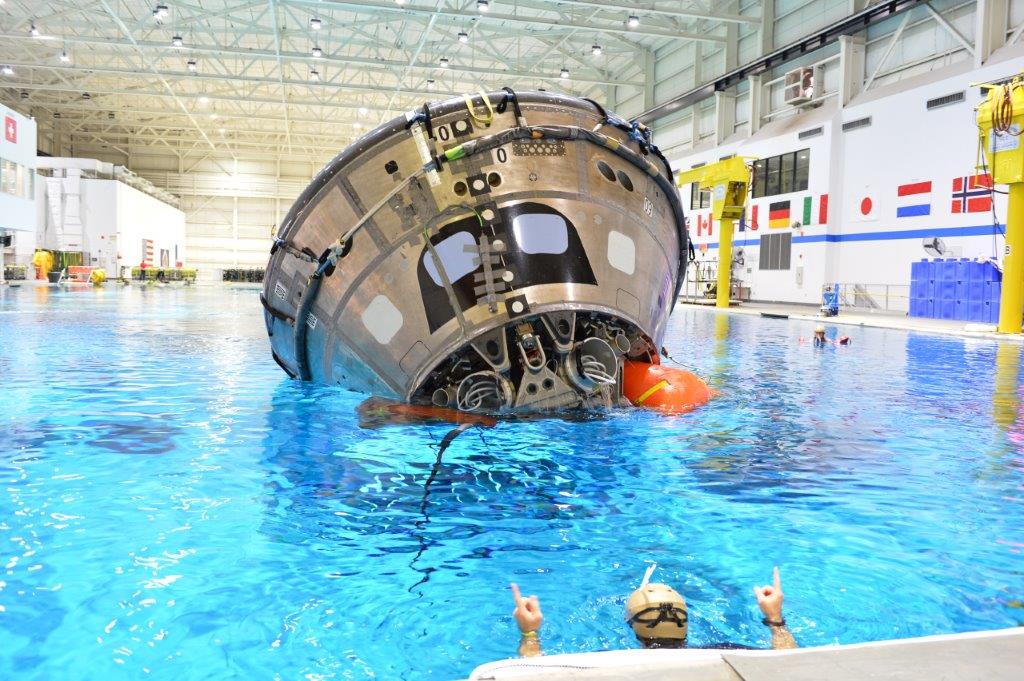Before walking on the moon, future astronauts may go for a swim.
The famed Neutral Buoyancy Laboratory (NBL) near NASA’s Johnson Space Center in Houston has trained hundreds of spacewalkers since 1992. All International Space Station crews spend many hours by simulated space modules in the large, indoor pool of water. There, they gradually get used to floating, turning screws, mounting hardware and other activities — all within reach of trained safety divers.
But with NASA now aiming to put astronauts on the moon, a part of the underwater facility is rapidly changing.
Nearby the ISS training area is a growing lunar-like world. Simulated sand and boulders (both natural and artificial) ornament the pool floor. Prototype spacesuits and lunar vehicles take dives.
Related: NASA prepares for moon’s dark south pole in eerie lights-out ‘spacewalk’
(opens in new tab)
Even the strange sun conditions on the moon are coming into focus, as company V2X experiments with the lighting that NASA astronauts will face at the moon’s south pole in 2025 or so, when Artemis 3 goes on the surface.
As NASA expands its Artemis program at the moon, the agency expects that commercial companies will quickly follow it there. Already an agency-supported program called Commercial Lunar Payload Services (CLPS) has a set of payloads, landers and rovers aiming to touch the surface as soon as this year.
V2X expects the demand to quickly grow, and they want to be ready with their underwater moon world for whoever needs to train for spacewalks in a strictly monitored environment.
Related: NASA is testing the first of its new moonwalking spacesuits
The company emphasizes that the work is being done carefully and procedurally to keep all participants safe and aware of the environment, just like other clients in NBL training (as the facility serves both NASA and commercial customers.)
“Everybody has to be laser-focused on safety at all times,” Clay Tomlinson, V2X program manager, told Space.com in an interview.
“It’s a very, very important thing to do not only for our people, but if you think about the astronauts who are training, we supply their breathing gas. We supply their cooling water. We supply all their videos,” he added.
Other moon work is also ongoing at the water surface level of NBL: V2X participated in simulated landing operations of the Artemis 1 mission after years of practice in the pool. That uncrewed 2022 mission not only sent the astronaut-rated Orion spacecraft around the moon for the first time, but had a flawless splashdown in part due to years of training and preparation for recovery operations.
“It could not have gone better,” Tomlinson said of the recovery, which happened after plenty of NBL practice to shelter from outside conditions in pristine, calm waters. As the team gained experience, they moved to the Gulf of Mexico “to simulate some more realistic states” in open water so the team would be ready for an Atlantic Ocean splashdown.

(opens in new tab)
The NBL was not available to astronauts in the 1960s and 1970s when the Apollo program last brought people to the moon, so a lot of new things are being learned to simulate moonwalks. Weights and flotations are used to keep spacesuited divers at one-sixth of the Earth’s gravity, similar to the moon’s conditions.
Lessons learned are drawn from all the literature available, too. For example, NASA has been practicing underwater excursions for years during its NASA Extreme Environment Mission Operations (NEEMO) missions. Swims and simulated ‘spacewalks’ happen near the submerged Aquarius habitat in coastal Florida. Astronauts and divers alike have partnered there for futuristic asteroid missions by humans, among other things.
Related: ‘Aquanauts’ complete mock asteroid mission on ocean floor
The NBL moon training will take advantage of a more controlled environment, however. Engineered sand, lying on the pool floor, is designed to mimic the regolith astronauts will step upon while on the lunar surface. Panels in the bottom of the tank are also being inserted to create inclines and declines, to help astronauts prepare for the sandy and steep slopes moonwalks require.
“It’s really becoming an impressive environment,” Tomlinson said, emphasizing the team will keep adapting and making careful safety adjustments as more experience comes in.
NASA has not put out any call for proposals yet for moonwalking training, but given how quickly commercial space is ramping up, V2X expects private customers will also need underwater simulations.
“We’re in a daring time,” said Tomlinson of the new moon push. The maturing space industry, he added, means customers are acting more like partners and working collectively to reach goals.
“You can feel that throughout the entire center,” added Tomlinson, who has been at NBL for eight years. “There’s excitement around the exploration and new challenges … it’s more [now] than I’ve seen previously.”
Elizabeth Howell is the co-author of “Why Am I Taller (opens in new tab)?” (ECW Press, 2022; with Canadian astronaut Dave Williams), a book about space medicine. Follow her on Twitter @howellspace (opens in new tab). Follow us on Twitter @Spacedotcom (opens in new tab) or Facebook (opens in new tab).


